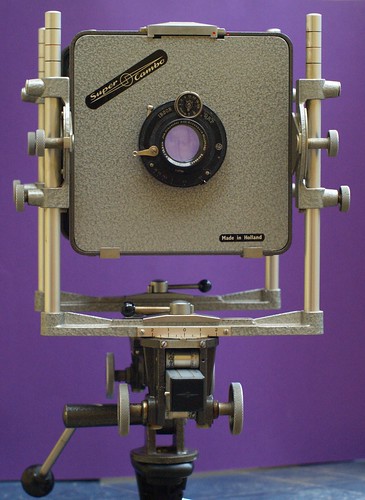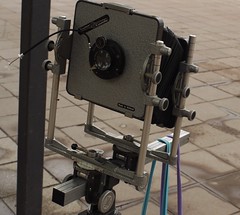Difference between revisions of "Super Cambo"
Hanskerensky (talk | contribs) (lay-out chance to improve readability) |
Hanskerensky (talk | contribs) |
||
| Line 12: | Line 12: | ||
The back has the typical facility of many 4x5 plate cameras: A focusing screen in a frame that also serves as clamp to fix the film holder. A [[Polaroid 545]] holder for enveloped daylight loading film sheets or enveloped instant film sheets will fit in that clamp. | The back has the typical facility of many 4x5 plate cameras: A focusing screen in a frame that also serves as clamp to fix the film holder. A [[Polaroid 545]] holder for enveloped daylight loading film sheets or enveloped instant film sheets will fit in that clamp. | ||
| − | |||
| − | |||
| − | |||
{{Flickr image | {{Flickr image | ||
| image_source=http://www.flickr.com/photos/uwe_kulick/4969727780/in/pool-camerawiki/ | | image_source=http://www.flickr.com/photos/uwe_kulick/4969727780/in/pool-camerawiki/ | ||
| image=http://farm5.static.flickr.com/4152/4969727780_674e60bd5a_m.jpg | | image=http://farm5.static.flickr.com/4152/4969727780_674e60bd5a_m.jpg | ||
| − | | image_align= | + | | image_align=left |
| image_text=in action | | image_text=in action | ||
| image_by= Uwe Kulick | | image_by= Uwe Kulick | ||
| image_rights= with permission | | image_rights= with permission | ||
}} | }} | ||
| + | {{br}} | ||
| + | == Super Cambo early models (1959-1963) == | ||
In 1959 the following models were introduced<ref name="PHT1989-3"/> : | In 1959 the following models were introduced<ref name="PHT1989-3"/> : | ||
* Super Cambo model I, 9x12cm (4x5"), 4.5kg weight | * Super Cambo model I, 9x12cm (4x5"), 4.5kg weight | ||
Revision as of 11:52, 27 August 2020

|
| with Schneider lens on Ibsor shutter image by Uwe Kulick (Image rights) |
The Super Cambo is a monorail camera, made by Cambo in the Netherlands from 1959 onwards[1]. It's not too heavy to be used just in a studio. The rail is made of aluminium. The other metal parts are made of iron, steel, and other heavier metals. It needs a tripod able to cope with a heavy workload. It has facilities for all variations of vertical and horizontal tilt and shift movement of back and/or lens board, including screws and levers to fix the parts in their positions. For making photos in nearness to the image subject a lens for a 9x12 camera might be sufficient. But flexibility is limited with such lenses because then back and lens board are quite near to each other. For full latitude of back and lens standard a special view camera lens is necessary. The big lever is for locking the rail's position in horizontal or tilted position. Back and front, either of them are positioned on the rail by means of a positioning control wheel paired with a position-locking screw-wheel.
The back has the typical facility of many 4x5 plate cameras: A focusing screen in a frame that also serves as clamp to fix the film holder. A Polaroid 545 holder for enveloped daylight loading film sheets or enveloped instant film sheets will fit in that clamp.

|
| in action image by Uwe Kulick (Image rights) |
Super Cambo early models (1959-1963)
In 1959 the following models were introduced[1] :
- Super Cambo model I, 9x12cm (4x5"), 4.5kg weight
- Super Cambo model II, 13x18cm (5x7"), 5kg weight
- Super Cambo model III, Combination 9x12cm (4x5") and 13x18cm (5x7"), 6kg weight
Super Cambo updates models (1963-1972)
In 1963 the Super Cambo series underwent a major update [1]. This did result in an easier handling of all the movements. The following models were available :
- Super Cambo model I, 6x9cm, bellows extension 30cm
- Super Cambo model II, 9x12cm (4x5"), bellows extension 44cm
- Super Cambo model III, 13x18cm (5x7"), bellows extension 54cm
- Super Cambo model IV, 18x24cm (8x10"), bellows extension 75cm
Notes
- ↑ 1.0 1.1 1.2 Article "Professionele Nederlandse Foto Apparatuur, Historie van Cambo" part 2, by Leo Hilkhuijzen in magazine PHT 3/1989 published by Fotografica